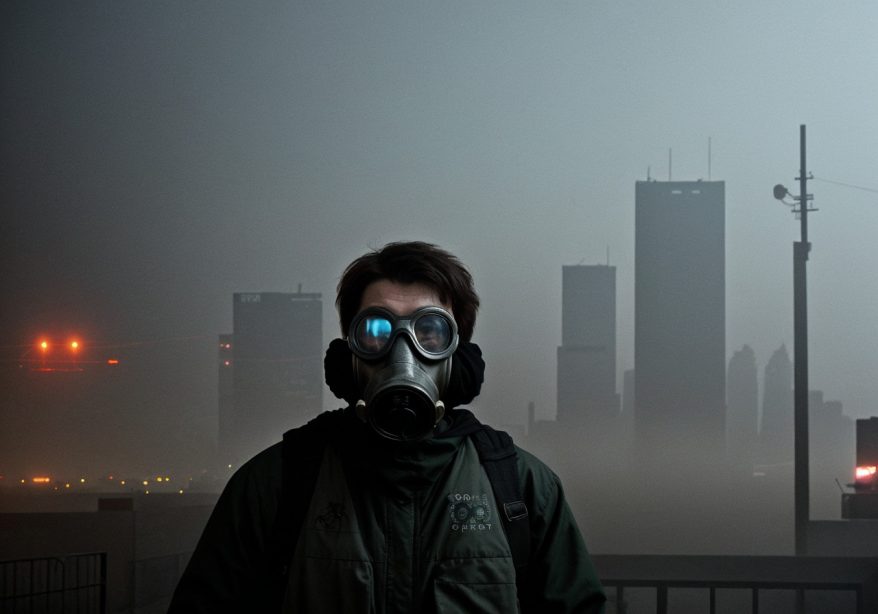Imagine waking up one morning to news that sends a shiver down your spine: the planet’s natural ability to cleanse itself is breaking down. The invisible hydroxyl radicals that usually scrub pollutants from the atmosphere are mysteriously disappearing. At first, you might shrug it off, but the signs start to show quickly—air pollution levels rising faster than anyone expected, respiratory issues becoming common, and a strange, metallic smell hanging in the air. You realize this isn’t just a temporary crisis; it’s the beginning of a disaster that will change everything.
Scenario Description:
In this scenario, a collapse of hydroxyl radicals in Earth’s atmosphere begins a terrifying chain reaction. Hydroxyl radicals are often called “the detergent of the atmosphere”—they react with pollutants, breaking down harmful chemicals and helping to keep the air clean. But what if these invisible scavengers were to vanish?
Scientists sound the alarm as hydroxyl levels plummet, leading to a rapid buildup of pollutants that would normally be neutralized. Without these critical molecules, toxic gases, chemicals, and particulates accumulate unchecked. The planet’s atmosphere becomes a toxic soup, filled with compounds that would have normally been broken down. You’re living in a world where each breath brings you closer to sickness, and the clean air you once took for granted is now as precious as gold.
Living Through a Hydroxyl Collapse:
As the hydroxyl collapse worsens, life changes drastically. Here are the stages you can expect to encounter—and tips on how to survive each phase:
1. Early Warning Signs:
At first, pollution levels spike noticeably. Cities like Beijing and Los Angeles, which have long struggled with air quality, face especially toxic conditions. Government agencies issue warnings about staying indoors, and air masks become a staple for those venturing outside. Stock up on high-quality air purifiers for your home, and get used to wearing a mask every time you step outside. Many people start investing in indoor plants known for air purification, like spider plants and peace lilies.
2. Breathing Becomes Hazardous:
As pollution intensifies, even those in rural areas start to feel the effects. Respiratory diseases become widespread, with more people suffering from chronic coughs, asthma, and bronchitis. Hospitals are overwhelmed with patients experiencing respiratory distress. At this stage, airtight rooms with ventilation systems become essential. Setting up an “air safe room” in your home—sealed and with a powerful air filtration system—could be a lifesaver.
3. Food and Water Contamination:
Pollutants start affecting food and water supplies. Toxic rain falls on crops, and fish populations in rivers and oceans suffer from chemical contamination. Many switch to indoor hydroponic gardens to grow safe, uncontaminated produce. Canned and preserved foods become essential, and bottled water is worth its weight in gold. Avoid eating locally caught fish or crops that aren’t thoroughly washed and tested for contaminants.
4. Economic and Social Collapse:
With agriculture crippled, food shortages become a major concern, driving up prices and increasing the risk of civil unrest. Many jobs become obsolete, particularly those that require outdoor work. Transportation grinds to a halt as smog thickens, and people can no longer commute safely. Cities begin to empty as people flee to safer rural areas—if there are any left. At this point, survival groups and local networks become invaluable. Stock up on essentials, build a community of trusted allies, and learn basic survival skills for a society on the brink.
5. Indoor Living Becomes the Norm:
Eventually, venturing outdoors becomes almost impossible. Entire communities are forced to live in sealed, climate-controlled environments. Schools, workplaces, and hospitals move underground or into enclosed “bio-domes” that maintain filtered air. Those who can’t afford such protection suffer immensely, and inequality becomes painfully visible. Self-sufficiency is critical here: learning to grow food indoors, purify air and water, and produce basic necessities without external supplies is the key to long-term survival.
Preventing a Hydroxyl Collapse:
Stopping a hydroxyl collapse would require massive, coordinated efforts across the globe. Here are some strategies that scientists and governments could pursue to avert this disaster:
1. Reducing Emissions and Pollutants:
One of the biggest contributors to hydroxyl depletion is the massive amount of pollutants released into the atmosphere. Governments would need to enact strict emissions standards, reduce reliance on fossil fuels, and promote renewable energy sources. Individual efforts, like reducing car usage, avoiding single-use plastics, and supporting sustainable products, could also play a small but vital role.
2. Reforestation and Ocean Conservation:
Forests and oceans help absorb pollutants, providing a buffer for the atmosphere. Protecting these ecosystems and investing in reforestation efforts could help reduce pollutant levels, easing the burden on hydroxyl radicals. Marine preservation efforts, such as reducing plastic pollution and fishing quotas, would also protect the ocean’s role in filtering air.
3. Atmospheric Engineering:
Scientists have proposed methods to artificially produce hydroxyl radicals in the atmosphere. These geoengineering projects are risky and controversial, as they would involve releasing chemicals into the air to simulate the effects of hydroxyl radicals. However, if a collapse were imminent, such drastic interventions might become necessary.
4. Public Awareness and Policy Change:
Raising awareness about hydroxyl collapse could help motivate policy changes and drive sustainable practices. Educating the public about the importance of air quality and supporting legislation that prioritizes environmental health would be crucial steps toward preventing such an apocalyptic outcome.
Surviving Long-Term in a Post-Hydroxyl Collapse World:
If hydroxyl levels don’t recover, humanity will be forced to adapt. Developing technology to replicate the functions of hydroxyl radicals, such as advanced air purification systems and indoor ecosystems, would be essential. Additionally, research into underground and underwater habitats could provide alternative living spaces if the surface becomes uninhabitable. With careful planning and resilience, some could survive—even thrive—in a world radically different from the one we know today.
Disclaimer:
This episode is a speculative exploration of a hydroxyl collapse scenario, inspired by scientific possibilities but not a confirmed threat. The purpose is to imagine how society might adapt and what changes could help prevent such outcomes. For accurate, real-world information on air quality and environmental health, please consult scientific sources and environmental experts.

